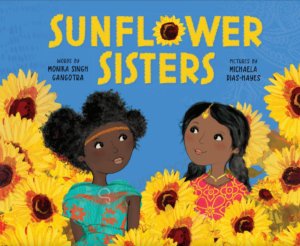Illustrator: Michaela Dias-Hayes
6 July 2021
28 pages
This month’s PB review is by Ryan G. Van Cleave (Owner/Operator of Only Picture Books) and freelance illustrator Edna Cabcabin Moran.
–Ryan’s Review of the Writing–
Right from the start, Monika Singh Gangotra’s picture book Sunflower Sisters leans into its primary topic–colorism (favoring light skin over dark skin). It’s not something often addressed in picture books, which is why I was so interested in reviewing this book.
Skin color comes up in the first scene because a pair of friends, Amrita and Kiki, each have older siblings who are getting married (not to each other). They’re playing outside, but as soon as the guests arrive, Amrita’s Aunty tells them to go inside because it’d be a bad idea to get a tan right before the weddings. It’s subtle, but that’s the first nod toward lighter being better than dark (from her perspective).
Once the children are in the house, Jas–Amrita’s sister and soon-to-be-bride of Shahid–is wearing cream to “make my skin look fair and bright.” Mom isn’t having that. She wipes it off and assure her daughter that she’s beautiful as is.
During bathtime, Amrita’s mom talks with her about a number of old wives tales, such as avoiding tea because it might make her skin lighter. “That’s ridiculous,” Amrita says with the wisdom of a child. And her mom agrees, assuring her–and the reader–that everyone’s skin is perfect regardless of its color. Light, dark, or any shade at all, it’s “EXACTLY as it is meant to be.”
Amrita’s Aunty clearly has outdated beliefs and customs. In addition to having given Jas the skin-lightening cream, she’s urging Amrita not to wear yellow because its brightness will only make her skin look darker. With the support of her mother–who doesn’t share the same beliefs as Aunty–Amrita wears yellow to her sister’s wedding.
As chance would have it, Kiki’s family is celebrating their own wedding on the other side of the street at the exact same time. Amrita notices Kiki is wearing bright colors, too. “Sunflower sisters!” they shout, promising to make each other feel like sunflowers every day. The final wordless images show a flash forward to the two kids owning their own clothing store and making runway-worthy sunflowery clothes.
A single page of back matter addresses the idea of colorism in a clear, helpful manner that’s suitable for young readers.
The best lines in the entire book happen when Amrita gets ready for for some before-bed tea after her bath, and Dondi says, “Yes you really are beautiful like the leaves in autumn. Do you know people travel from miles around to see the browns and golds of the changing leaves? It’s a marvel, just like you.” That’s lovely and empowering. Clearly not all adults are as locked into old ideas and traditions as is Aunty.
For those wanting more of a plot, they might find the book wanting since both children don’t have a lot of agency. The conflict here is ideological, but not one Amrita really faces firsthand since she is fully supported by Mom in every instance. While that’s a terrific thing in life, it’s less useful to include always-there, always-supportive adults in picture books since most readers want to see kids solve (or at least try to solve) their own problems. Also, there are a lot of characters here–two named neighbors, two kids, parents, other adults, wedding guests, etc., plus Amrita is also called “Beta,” so it’s possible independent readers might get confused, though the pictures might help them through those moments.
But make no mistake–the topic of colorism is book-worthy. In an interview about Sunflower Sisters, the author explained her motivation behind the book and how she grew up with the underlying fear that if she became darker skinned, she’d be unworthy of love and unable to obtain success. “I was advised when attending social South Asian events that certain colours, such as yellow, would make my skin look darker and that I should probably choose another colour, no matter how much joy wearing it would bring me. These comments made by loved ones and strangers alike were not malicious. The comments and guidance were always well meaning and not intended to hurt us. They were done so because they thought they were protecting us and helping us live a life full of opportunity – ones that we would simply not be offered if our skin was darker.” To see the rest of the interview, check it out at My Book Corner.
In sum, the book has two weddings (fun!), two cool kids (fun!), and lots of terrific artwork (fun!). Plus, the story deals with a little-talked-about topic in an appropriate, empowering way. Those things alone merit consideration for this book being added to your To-Read list.
3.75 out of 5 pencils
–Edna’s Review of the Illustrations–
The picture book, Sunflower Sisters, is bedecked in vibrant colors emanating from collage-infused, stylized illustrations. Artist Michaela Dias-Hayes creates charming characters set in stage-like scenes in a tale of beauty standards and friendship told by Monika Singh Gangotra. But there is more to Dias-Hayes’ use of buoyant, fun colors. Before color is even mentioned in the story, Dias-Hayes suggests yellow as something beyond artistic element or device. I’d venture to say that Dias-Hayes uses yellow as a character itself in the story.
In the opening scene, we see clusters of yellow sunflowers along the sides of the house and near the front entrance–an homage to the title of the book. Subtle yellow paint textures the house that serves as a backdrop for strings of yellow and white lights. The house’s triangular features on the upper level is painted golden yellow. It occupies the center of the page like an arrow pointing up to the sky, perhaps alluding toward higher ideals.
We are brought in a bit closer to characters on the opposite page which depicts Amrita, the main character, hugging her visiting aunt who advises that Amrita come in “out of the sun.” They are framed by splashes of yellow from sunflowers, Kiki’s dress, and a multitude of stringed bulbs dangling down from the house and along Amrita’s dad’s shoulders.
Then yellow is used sparingly–quieted down–in subsequent page spreads as Amrita receives both direct and subtle messages regarding dark skin tone versus whiteness–misleading, negative notions from older female relatives. On a shopping excursion, Amrita expresses her preference for dressing in yellow “like the sunflowers” and several aunties are depicted gasping with disapproval on a page devoid of the color yellow. “YELLOW?” they say, “With YOUR complexion?”
The story switches to a positive direction when Amrita’s Mom brings out a yellow “lehenga” outfit from her girlhood and gives it to Amrita to wear. Dias-Hayes takes the color yellow into high gear transporting Amrita and her mom to a field of sunflowers–a jubilant page filled with golden yellows.
In contrast with its earlier single page scenes, the remainder of the book is comprised of scenes spanning the length of each spread–from Amrita’s sister’s wedding and the neighbors’ wedding scenes to the final fashion catwalk scene. All are resplendent in subtle touches of yellow glowing in the background while foreground colors host bright, bold yellow markers directing our eyes around the spread.
My only critique of Dias-Haye’s illustrations is the uneven anatomical features and character proportions. There is a look and feel of characters being created separately and pasted into place like paper dolls. But these are minor details in the scheme of things. Dias-Hayes has a strong design sensibility with a charming style. Through her expert use of color we are treated to a world that is bright and fun, bouncing with energy, while also grounded in a compelling color story filled with hope and gravitas.
4.5 out of 5 crayons
 Edna Cabcabin Moran is an author/illustrator, multi-disciplined artist, educator, and advocate for youth voices and diversity in publishing. She is also a dancer with acclaimed hālau hula and dance company, Nā Lei Hulu I Ka Wēkiu, and a teaching artist specializing in STEAM and integrative arts. She has served on several nonprofit committees including We Need Diverse Books and Alternative in Action’s Project Youthview: The Power of Youth in Film.
Edna Cabcabin Moran is an author/illustrator, multi-disciplined artist, educator, and advocate for youth voices and diversity in publishing. She is also a dancer with acclaimed hālau hula and dance company, Nā Lei Hulu I Ka Wēkiu, and a teaching artist specializing in STEAM and integrative arts. She has served on several nonprofit committees including We Need Diverse Books and Alternative in Action’s Project Youthview: The Power of Youth in Film.
IG & Twitter: @kidlitedna


